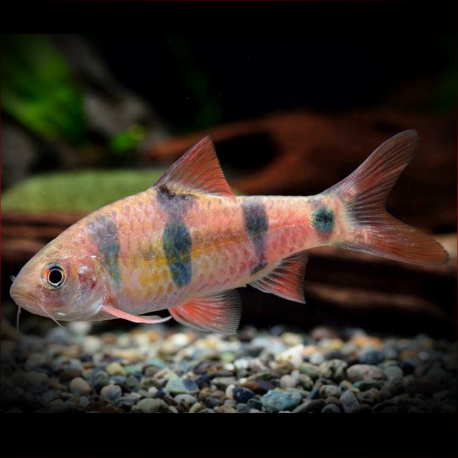More info
Datasheet
| Minimum Tank Size | 240 litres / 63.40 US gallons |
| Maximum Size | 12.0cm / 4.72inches |
| Temperature | 18°C / 64.40°F - 28°C / 82.40°F |
| Hardness | 2.02dgH / 36ppm - 10.03dgH / 179ppm |
| pH | 6.0-7.0 |
General Description
Barbodes everetti, previously misapplied to Barbodes dunckeri, is a species of cyprinid fish distinguished by its vibrant coloration, specifically larger dark body markings and absence of a blotch at the dorsal-fin base compared to B. dunckeri. Typically reaching a maximum size of 12.0 cm, this species was transferred from the genus Puntius to Barbodes due to taxonomic revisions in Southeast Asian fishes. Known for its schooling nature, B. everetti thrives when kept in groups of 6 or more individuals to reduce skittish behavior and promote a natural display.
Aquarium Setup
To recreate its natural habitat effectively, a tank for Barbodes everetti should mimic a flowing stream or river. The setup should include a substrate of water-worn rocks, sand, fine gravel, and possibly small boulders. Driftwood roots or branches can be added, along with hardy aquatic plants like Microsorum, Bolbitis, or Anubias spp. While not demanding torrent-like conditions, maintaining high water quality with dissolved oxygen and moderate water movement is crucial. Regular 30-50% weekly water changes are recommended to prevent the accumulation of organic pollutants.
Behaviour
Being a schooling species, Barbodes everetti thrives when housed with peaceful, similarly-sized fish in a community tank. This species tends to maintain a hierarchical order within the group, displaying minimal aggressive behavior when kept in appropriate numbers. Researching and selecting compatible tank mates is essential to avoid conflicts and ensure a harmonious environment.
Feeding and Diet
Barbodes everetti is an omnivorous species that feeds on a variety of organisms in its natural habitat, such as worms, insects, crustaceans, and plant matter. In captivity, they readily accept small live and frozen foods like bloodworms, Daphnia, and Artemia, in addition to high-quality dried flakes and granules. A balanced diet contributes to the optimal health and coloration of these fish.
Reproduction & Dimorphism
Although the specific reproduction behavior of B. everetti is not well-documented, closely-related species suggest that they are egg-scattering free spawners without parental care. Successful breeding may require a separate breeding tank with dim lighting, a suitable substrate for egg collection, and proper water conditions. Adult males exhibit more intense coloration and tubercules on the head during spawning, while females tend to be larger and less colorful.
Habitat and Distribution
Endemic to Sarawak and parts of Kalimantan Barat in East Malaysia, Barbodes everetti is commonly found in forest streams with clear water and variable flow. It also inhabits shallow water environments like forest pools, often coexisting with species like Rasbora sarawakensis, Barbodes banksi, and B. kuchingensis. While reported to occur in parts of Kalimantan and the Riau Islands in Indonesia, its presence in Sumatra remains unverified.

